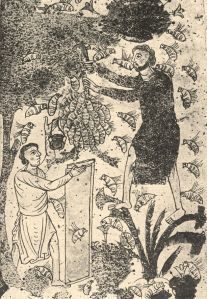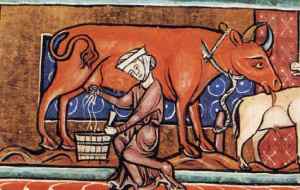Burglar Bees
Did you ever think about bees and beekeepers and the fact that they might be stealing? Probably not, but just for a minute, do. The beekeeper has his bees and they fly merrily off looking for pollen, zooming into  neighbouring fields and the flowers growing within. They take the pollen back to their hives and turn it into honey, and thus commit the perfect crime. The owner of the fields and flowers would never demand part of the profits of the honey, that’s just mad. Even though it was his pollen that was made into the honey. And you can’t blame the bees, they are just being bees. But it would make a certain amount of sense. If you employed a smattering of disorderly kleptomaniac children to go and steal millions tons of coffee beans from farmers and process them into coffee you can be sure the authorities would have words with you. But not for bees and pollen. How would you even police them? How do you tell the offending bees apart from the innocent ones? That’s just crazy, right? Probably, unless you are living in Ireland in the early middle-ages. They had laws about bees. The even had laws about distraining (a fancy word for seizing or impounding) the little thieves in the event you caught one trespassing on your land. Since that would be near impossible, and pointless, they came up with rules to share the honey, or its profits, out fairly. The beekeeper got the most, of course, but a certain amount was shared out to neighbouring farmers, as was fair. A thoroughly weird law that makes a certain amount of sense.
neighbouring fields and the flowers growing within. They take the pollen back to their hives and turn it into honey, and thus commit the perfect crime. The owner of the fields and flowers would never demand part of the profits of the honey, that’s just mad. Even though it was his pollen that was made into the honey. And you can’t blame the bees, they are just being bees. But it would make a certain amount of sense. If you employed a smattering of disorderly kleptomaniac children to go and steal millions tons of coffee beans from farmers and process them into coffee you can be sure the authorities would have words with you. But not for bees and pollen. How would you even police them? How do you tell the offending bees apart from the innocent ones? That’s just crazy, right? Probably, unless you are living in Ireland in the early middle-ages. They had laws about bees. The even had laws about distraining (a fancy word for seizing or impounding) the little thieves in the event you caught one trespassing on your land. Since that would be near impossible, and pointless, they came up with rules to share the honey, or its profits, out fairly. The beekeeper got the most, of course, but a certain amount was shared out to neighbouring farmers, as was fair. A thoroughly weird law that makes a certain amount of sense.
My Wife Made Me Do It
Pregnant women’s cravings were covered by Brehon Law. Hard to believe, but it’s true. If a pregnant woman craved carrots and her husband had none but went and stole some for her he was exempt from the law. He could satisfy her cravings, within reason, and not be prosecuted for theft. Which is an absolutely brilliant law. The Brehon lawyers were very wise men who listened to their wives and saved the lives of many husbands.
Welcome Back! Now Die…
The medieval Irish had some really interesting ways of dealing with serious crimes like murder. One punishment involved putting the offender in a boat without oars, swim-trunks or flippie-floppies. The idea was that the gods, and later God, would decide the fate of the condemned. If the boat went out to sea the person died, or ended up in England, solving the problem, which allowed for a certain level of moral ambiguity. If the individual was washed back ashore they were free to live out their lives. Delightfully civilised. Except for the fact that they were no longer protected by the law, they were literally outlaws. Since they were no longer protected by the law anyone could kill them with impunity. If you had killed someone, their entire family would wait at the shore hoping you would be returned to them by the winds and the will of God, not to forgive you or give you a cake, but to do some rather nasty things to you. If you were on a boat you wouldn’t be singing songs about how cool you were but instead be praying to come ashore somewhere very far away and then find your way with great haste to the nearest lord and seeking his protection.
First you get the Cows, Then you get the Women…
The early Irish had interesting forms of currency. We have the cent and the euro, the Vikings had shillings, but the early Irish used séts, cumals, cattle and silver. The last two are rather self-explanatory.  A sét is simply ‘a valuable thing’, such as jewellery. 1 milk cow was worth an ounce of silver, 2 valuable things, or a third of a sét. The value of the sét could vary wildly from time to time, especially in times of scarcity, not unlike the dollar or the price of oil. It sometimes rose in value to equal 10 cows. Which doesn’t sound very exciting to modern ears, but in those days cows were like walking lump of silver. Silver that reproduced, made milk, could be eaten and turned into leather, making it even more valuable. You could imagine that they were worth thousands of pounds, leather bound pounds. What was a cumal? The lowest king was worth seven of them, the highest twice as much. What could be worth so much? A cumal was a female slave. Male slave were not used as currency and were called mugs, which is somewhat apt.
A sét is simply ‘a valuable thing’, such as jewellery. 1 milk cow was worth an ounce of silver, 2 valuable things, or a third of a sét. The value of the sét could vary wildly from time to time, especially in times of scarcity, not unlike the dollar or the price of oil. It sometimes rose in value to equal 10 cows. Which doesn’t sound very exciting to modern ears, but in those days cows were like walking lump of silver. Silver that reproduced, made milk, could be eaten and turned into leather, making it even more valuable. You could imagine that they were worth thousands of pounds, leather bound pounds. What was a cumal? The lowest king was worth seven of them, the highest twice as much. What could be worth so much? A cumal was a female slave. Male slave were not used as currency and were called mugs, which is somewhat apt.


